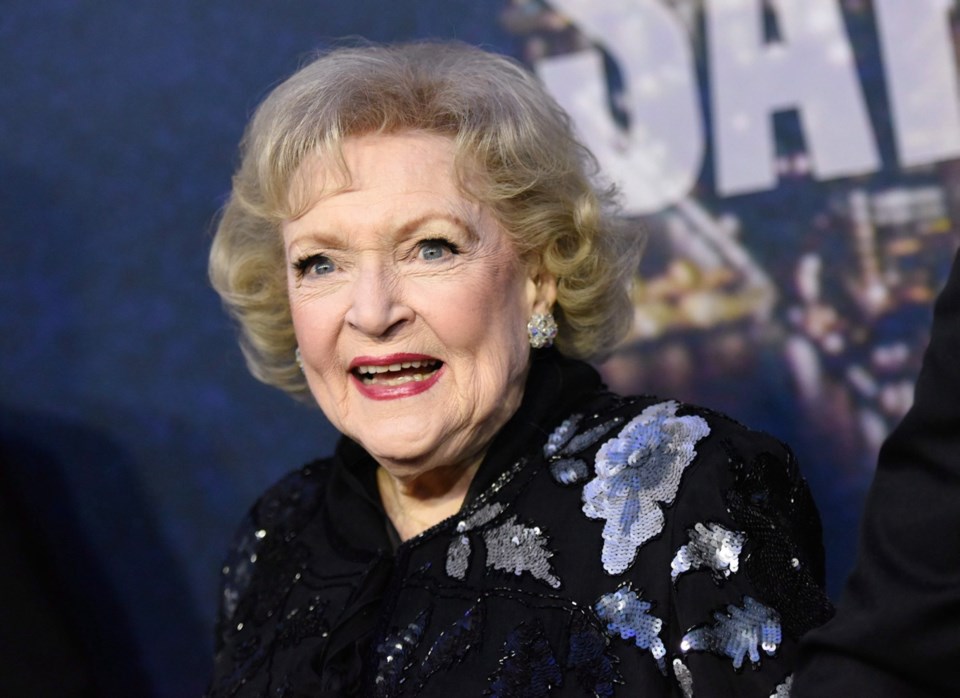TORONTO — Television broadcasting did not begin in Canada until September of 1952.
By that point, Betty White was already a TV veteran.
“My husband, Allen Ludden, always said: ‘My wife was a pioneer in silent television, ” she joked at a 2007 press conference. “It was kind of close.”
The 96-year-old actress, best known for her memorable characters on The Mary Tyler Moore Show, The Golden Girls and, most recently, Hot in Cleveland, will be saluted Tuesday on the PBS documentary Betty White: First Lady of Television.
If she wasn’t the very first lady, she was damn close. In 1939, White was fresh out of high school when she sang at an experimental Los Angeles TV station. Ten years later, as commercial TV gained a footing in America, she began co-hosting a daily variety series.
The male host, Al Jarvis, asked if White would be his ‘Girl
Friday,’ ” she recalled, “which I thought, gee, that’s wonderful.
I didn’t realize it was going to be Monday, Tuesday, Wednesday, Thursday, Friday, Saturday.”
By 1952, she was sole host, singing and ad libbing her way through five-and-a-half hours of TV a day, six days a week. A year later, she was starring in and producing her own sitcom, Life With Elizabeth.
Consider that accomplishment. White was a player in the TV
business back when Milton Berle, Lucille Ball, Groucho Marx and Jackie Gleason dominated the medium. Jump ahead 60 years, and at 88 she spiked ratings as the oldest Saturday Night Live host ever.
That same year — 2010 — she tickled a new generation by getting tackled in a memorable Super Bowl chocolate bar ad.
Steve Boettcher, the producer/co-director of the documentary, told reporters gathered in Los Angeles last month that White has put on a lifelong
“master class on staying relevant, current, in a constantly changing business.”
White was not at PBS’s press conference that day. Boettcher explained that, while she was doing fine, “after 80 years in show business, she deserves a day off.”
Three of her former co-stars, however, did attend the session: Gavin MacLeod (Murray) and Georgia Engel (Georgette) from The Mary Tyler Moore Show and Arthur Duncan, who, before he went on to The Lawrence Welk Show, was showcased on White’s 1954 daytime talk show.
Duncan, a tap dancer, told reporters that White used her clout as an early TV star to keep him on her talk show.
He said some viewers and sponsors objected to his presence as an African-American performer. White also served as producer and her response to the protests was to use Duncan every chance she could.
“I think she just stood up for her beliefs,” Duncan told reporters, “and that ended that.”
MacLeod says viewers forget what big shoes White had to fill when Valerie Harper left The Mary Tyler Moore Show to do her spin-off series, Rhoda.
“Can you imagine when she left, we didn’t know quite what was going to be happening.”
Then White’s happy homemaker character Sue Ann Nivens showed up, says MacLeod, and “we were home free again.”
White was asked at that 2007 press conference if she ever planned to retire. She offered an answer quoting another first lady of television, Carol Burnett, frequently gives to the same question.
“She says: ‘You know how in a mystery play, when you open the door, there’s a skeleton hanging on the door and it rattles? I’m going to wind up being that skeleton.’ ”

-thumb.png;w=120;h=80;mode=crop)

